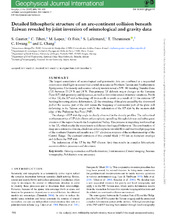| dc.contributor.author | Gautier, S | |
| dc.contributor.author | Tiberi, C | |
| dc.contributor.author | Lopez, M | |
| dc.contributor.author | Foix, O | |
| dc.contributor.author | Lallemand, S. | |
| dc.contributor.author | Theunissen, Thomas | |
| dc.contributor.author | Hwang, C | |
| dc.contributor.author | Chang, E | |
| dc.date.accessioned | 2020-06-25T09:38:37Z | |
| dc.date.available | 2020-06-25T09:38:37Z | |
| dc.date.issued | 2019 | |
| dc.Published | Gautier, Tiberi, Lopez M, Foix, Lallemand S, Theunissen T, Hwang, Chang. Detailed lithospheric structure of an arc-continent collision beneath Taiwan revealed by joint inversion of seismological and gravity data. Geophysical Journal International. 2019;218(1):586-600 | eng |
| dc.identifier.issn | 0956-540X | en_US |
| dc.identifier.issn | 1365-246X | en_US |
| dc.identifier.uri | https://hdl.handle.net/1956/22961 | |
| dc.description.abstract | The largest compilation of seismological and gravimetry data are combined in a sequential inversion to shed light on unresolved crustal structures in Northern Taiwan and Southernmost Ryukyu area. Our density and seismic velocity models reveal a NW–SE trending Transfer Zone (TZ) between 23.25°N and 24°N. This primary TZ delimits major changes in the Eurasian Plate (EP) slab geometry and dynamics, as well as first order crustal structure variations. North of this TZ, the EP slab is breaking off from north to south as a result of (1) the extreme EP bending favouring plastic deformation, (2) the stretching of the plate caused by the downward pull of the oceanic part of the slab versus the buoyancy of continental part of the plate still deforming in the Taiwan orogen and (3) the indentation of the EP slab by the western slab edge of the Philippine Sea Plate (PSP). The change of EP slab dip angle is clearly observed in the density profiles. The subvertical northernmost tip of EP slab allows asthenospheric upwelling through slab tear and subsequent invasion of the region beneath the Longitudinal Valley. This process is migrating southward up to the TZ, which marks the transition to a different rheological behaviour. The combination of deep arc-continent collision, clockwise asthenospheric toroidal flow and westward propagation of the southern Okinawa rift results in a 100° clockwise rotation of the northernmost tip of the Central Range. The eastward extrusion of this crustal block (∼90 km in diameter) overlays and deflects the PSP slab. The indentation of the EP by the PSP (Luzon Arc) thus results in complex lithospheric accommodation processes and structures. | en_US |
| dc.language.iso | eng | eng |
| dc.publisher | Oxford University Press | en_US |
| dc.title | Detailed lithospheric structure of an arc-continent collision beneathTaiwan revealed by joint inversion of seismological and gravity data | en_US |
| dc.type | Peer reviewed | |
| dc.type | Journal article | |
| dc.date.updated | 2020-02-19T10:12:34Z | |
| dc.description.version | publishedVersion | en_US |
| dc.rights.holder | This article has been accepted for publication in Geophysical Journal International ©: 2019 The Authors. Published by Oxford University Press on behalf of the Royal Astronomical Society. All rights reserved. | en_US |
| dc.identifier.doi | https://doi.org/10.1093/gji/ggz159 | |
| dc.identifier.cristin | 1724173 | |
| dc.source.journal | Geophysical Journal International | |
